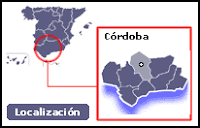 Lucena (Córdoba) is a municipality in the province of Cordoba, Andalucia, Spain. Located 71 kilometers south of the capital of the province of Cordoba.
Lucena (Córdoba) is a municipality in the province of Cordoba, Andalucia, Spain. Located 71 kilometers south of the capital of the province of Cordoba. Its name comes from Eli Hosanna (from Hebrero ... "God save us"). It was named for the Jews, the Muslims called Al Yussana.
Others think that your home is older.
During the Middle Ages was known for such beautiful names as "La Perla de Sefarad " and " City poetry."
seems that Lucena is the people of Spain that has more trees in every municipality.
has about 41,000 inhabitants, but during working hours may rise to 43,000 by the neighboring towns, becoming the most populous town in the province of Cordoba, after the capital and industrial powerhouse of the region of the Subbética and the center of Andalusia, near Antequera.
Lucena was among the 10 industrial populations of Andalusia in 2009. (" date data sent by a Lucena).
Archaeological Museum of Lucena:
Located in the Castle del Moral, civil building XIV century military.
works as a look in the mirror of the past, life, culture, and our own personal and collective identity.
has 10 rooms, ranging from the evolution of the earth, until now.
has 10 rooms, ranging from the evolution of the earth, until now.
La Cueva del Angel (Screenplay)
gallery is located in the west of Castillo. Recreates the life and environment of Neanderthals and preneandertales, at the site of the Cueva del Angel, in the Sierra Aras.
spaces were recreated the Neanderthal cave where a woman fuels the fire and a dealer builds a wooden ax.
Torre del Moral:
+copia.jpg) Located near Coso, old place outside its walls, is a National Historic Landmark. Its oldest part, corresponding to the core, was probably built in the eleventh century during the city's Jewish. The factory is square with corner towers. The latter emphasizes the Moral tower, and octagonal baroque preserves its cover.
Located near Coso, old place outside its walls, is a National Historic Landmark. Its oldest part, corresponding to the core, was probably built in the eleventh century during the city's Jewish. The factory is square with corner towers. The latter emphasizes the Moral tower, and octagonal baroque preserves its cover. is considered a small cathedral, and is one of the oldest and most beautiful churches in the province of Cordoba.
surely its location in the synagogue and then found the mosque, but was adapted to Christian worship in 1,240.
San Miguel's cover is 1544, the transition from Gothic to Renaissance.
Conventual Church of the Mother of God (San Francisco)
Founded in 1558, and subsequently amended in 1620. Presents a simple cover Mannerist.
is built on an old medieval chapel and was carried out on traces of the master builder (architect or master builder) Malaga Francisco de Lucena.
With a Latin cross and dome light on the cruise. Its facade is a wall of brick.
Parish Church of Santiago:
Gothic-Mudejar temple XVI century. National Historic Monument
Parish of Our Lady of Carmen:
+copia.jpg) Located on a hill above the typical neighborhood of the barrier, was a temple convent of the Order of Discalced Carmelites. Built at 1,630
Located on a hill above the typical neighborhood of the barrier, was a temple convent of the Order of Discalced Carmelites. Built at 1,630 following the Carmelite artistic standards in fashion, in a severe baroque purist. Is a clear example of the architectural evolution Mannerism to the Baroque and the remarkable influence of Herrera in the architecture of the first half of the seventeenth century.
+copia.jpg) ancient lineage Homes , stately, baroque style. Homes
ancient lineage Homes , stately, baroque style. Homes noables, highlight windows and balconies of the architecture. Examples:
House of the Recio Chacon Rico House of Duende, Casa de los Condes de Hust.
.
+copia.jpg)
adjective: Lucentino / a
+copia.jpg)
adjective: Lucentino / a
personal experience:
One morning, just as sunny as the day before, we come to know this people.
Small sample of the impressive architecture of Lucena.
Lucena, a city of Cordoba under which few suspect white appearance hides an extraordinary story: the story of the pearl of Sefarad. There was the most important rabbinical academy in the Jewish world between the ninth to twelfth centuries, preferably. A flowered garden where poetry and the study as only occurred later in Toledo. ____________________________________________________
addition to its architecture, Lucena has some ecological landscape, an environment privileged, which is to visit, such as Mount Aras and Bitter lakes, of Jarales, Malpasillo reservoir, the "Lake of Andalusia" - and their viewpoints.
+copia.jpg)
+copia.jpg)
+copia.jpg)
+copia.jpg)
+copia.jpg)
+copia.jpg)
+copia.jpg)
+copia.jpg)
+copia.jpg)
+copia.jpg)
+copia.jpg)
+copia.jpg)
+copia.jpg)
+copia.jpg)
+copia.jpg)




















.jpg)














